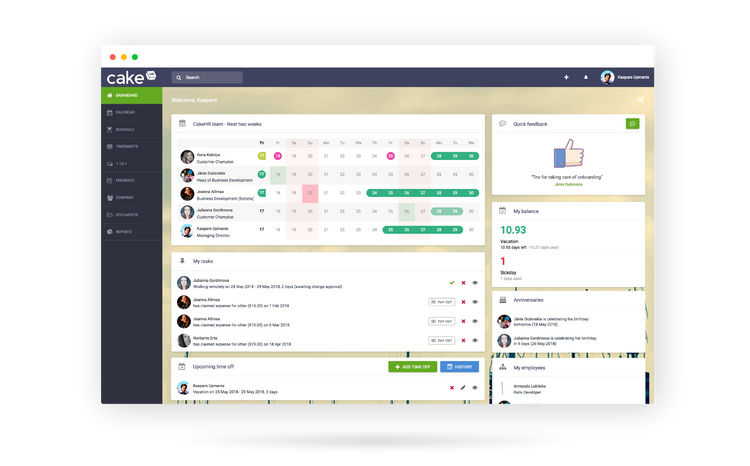The Best Vacation Tracking Software
Get the best software for your business. Compare product reviews, pricing below.
What is Vacation Tracking Software?
Vacation tracking software streamlines the many human resource (HR) processes involved with scheduling time off for employees from a single, comprehensive platform. Vacation tracking used to mean making a spreadsheet and filling in time off requests as employees made them. Yet this could often cause problems with overlapping vacations leading to a lack of coverage at your company.
While there is some functionality overlap with time and attendance software, vacation tracking systems focus only on time when employees are away, not when they are at work. This may cover just paid time off (PTO), unpaid leave, or any extended employee absences from your company. Whatever your vacation policy, PTO tracking software makes it easy to coordinate employee time off.

Features of Vacation Tracking Software
- Vacation calendar: Show approved and pending time off on a shared calendar which can be updated and edited at any time
- PTO management: Add or modify vacation, sick days, bereavement leave, parental leave, holidays, and any other type of paid time off for employees
- Eligibility requirements: Set rules and guidelines on who is eligible for different types of time off; mark blackout dates in a shared calendar for unavailable dates
- Leave balance and time calculator: Show how much paid or unpaid time off has been accrued by each employee, then balance PTO accruals against how much leave has been taken already
- Roll-over limits and leave encashment: Determine how vacation time rolls over for future usage or expires
- Leave encashment: Calculate payout or buy out compensation for employees who have not used their carryover/rollover leave at the end of their time with your company
- Automated notifications and alert reminders: Avoid coverage lapse by sending automatic email or text reminders to employees about to go on vacation and their managers, supervisors, or teams
- Employee self-service portals: Allow employees access to their leave requests from desktop or mobile devices, also clock-in and clock-out
Best Vacation Tracking Software Benefits
Utilizing a vacation tracking system at your company can provide many long-term and short-term benefits:
Real-Time Vacation Updates
Employee time is one of the most valuable resources your company has. Yet filling out timesheets can be a real drain on company resources, particularly small businesses without dedicated HR staff. Add in a backlog of leave requests around popular holidays and even an experienced PTO tracker can make a mistake on the official timesheet.
Instead of relying on HR teams filling in a vacation tracking spreadsheet manually in Excel, this management software lets HR, managers, and employees themselves add in time off requests for approval. This workflow automation means HR and management can focus on other tasks than deciding how employees schedule their time off.
Clear Coverage Calendar
Vacation tracking software uses synchronized calendars to share time off information with the entire company. Anyone can login to check coverage on specific dates while approved users can add or modify leave. If your company offers vacation time off on a first come, first serve basis, a software which updates a vacation calendar in real-time can be invaluable for preventing disagreements about who can take vacation and when by automatically blocking off dates as they fill up.
For HR managers and teams, this can free up a lot of valuable time trying to balance time off while maintaining adequate coverage for each department. The calendar can show which days have already been taken off by other employees, limiting who else can schedule a vacation. Less time spent on spreadsheets means more time actually enjoying vacation.
Of course, some departments are more necessary for daily operations than others. Employed data such as eligibility requirements can indicate who can take vacation at any given time and who still needs approval from higher ups. And using this automated approval process can avoid accusations of favoritism on the schedule.
Employee Leave Compliance
Depending on where your company is located, there are labor laws which determine time off minimums and overtime compensation for employees. While you are free to develop custom leave policies for your company, they must still meet state or federal requirements. For instance, you may not be required to offer paid vacation to part-time workers, as long as unpaid leave opportunities are available instead. And COVID-related quarantine and sick leave needs to be handled extra carefully to remain compliant with federal mandates.
While an employee opting to spend their time working is invaluable, it can lead to an issue of leave encashment further down the line. Your vacation tracking software can double as a sort of performance management tool for encouraging hard-working employees to take their earned time off when it’s available. Along with preventing leave encashment in the future, this also prevents potential burnout from overextending themselves on the job.
Vacation Tracking Software Trends
There are several interesting time off and vacation tracking trends modern business need to be aware of, such as:
Personal PTO Tracker Apps
Customizable mobile apps let employees access their vacation time from anywhere on any device. Now, instead of going to the HR department with a formal time off request, they can arrange their own vacation and get automatic approval almost instantaneously. And apps can also turn down vacation time requests which are not allowed, being the bad guy instead of HR.
These accessible apps make leave management easier than ever, freeing up HR teams, supervisors, and managers from endless time tracking spreadsheets. System automation expedites the vacation approval process, while potential conflicts are avoided. And in the event there is overlap between two or more vacation requests, the software makes it easy for HR to step in and sort out who gets leave priority.
Vacation, PTO, and Sick Leave Exchange
Certain companies draw very clear distinctions between vacation time, individual PTO, sick leave, and bereavement. Others just offer a set amount of hours to cover all of the above. Today, it’s far more common for companies to create flexible leave plans to better accommodate employees.
For example, many companies allow employees to bank additional time off by working overtime. Vacation tracking software notes these accruals to show how much total PTO an employee has earned. This time can then be used for arranging extended leave, whether it’s an unexpected sick day or an extra day off for a long weekend.
Floating Vacation Availability
Some companies used to require vacation days be used consecutively in order to avoid the time off being used interchangeably with PTO or sick days. Yet as more companies offer flexible work arrangements (FWAs), vacation days are no longer tied to one another, allowing employees more flexibility for planning time away from work. Vacation tracking software is useful for keeping tabs on exactly how many hours or days of PTO are left for each employee.
Vacation Tracking Software Pricing
Vacation software pricing depends on several variables. First, HR software in general is often priced based on how many workers your company has, especially if they will all need access to an employee self-service portal. Next, the different types of vacation available to your employees may also increase the cost, as you’ll need ways to differentiate between paid time off and unpaid leave.
Fortunately, standalone vacation tracking systems are generally more affordable than full-service HR software. Costs may be as low as $1 per employee per month. Free vacation tracking software is available, although there are usually costs for additional features, training, and add-ons. For instance, integration with payroll software, which allows you to pay employees based on leave encashment, can increase the price. Other integration options may include email and chat features so key employees can receive automated alerts whenever someone is out for any reason.

